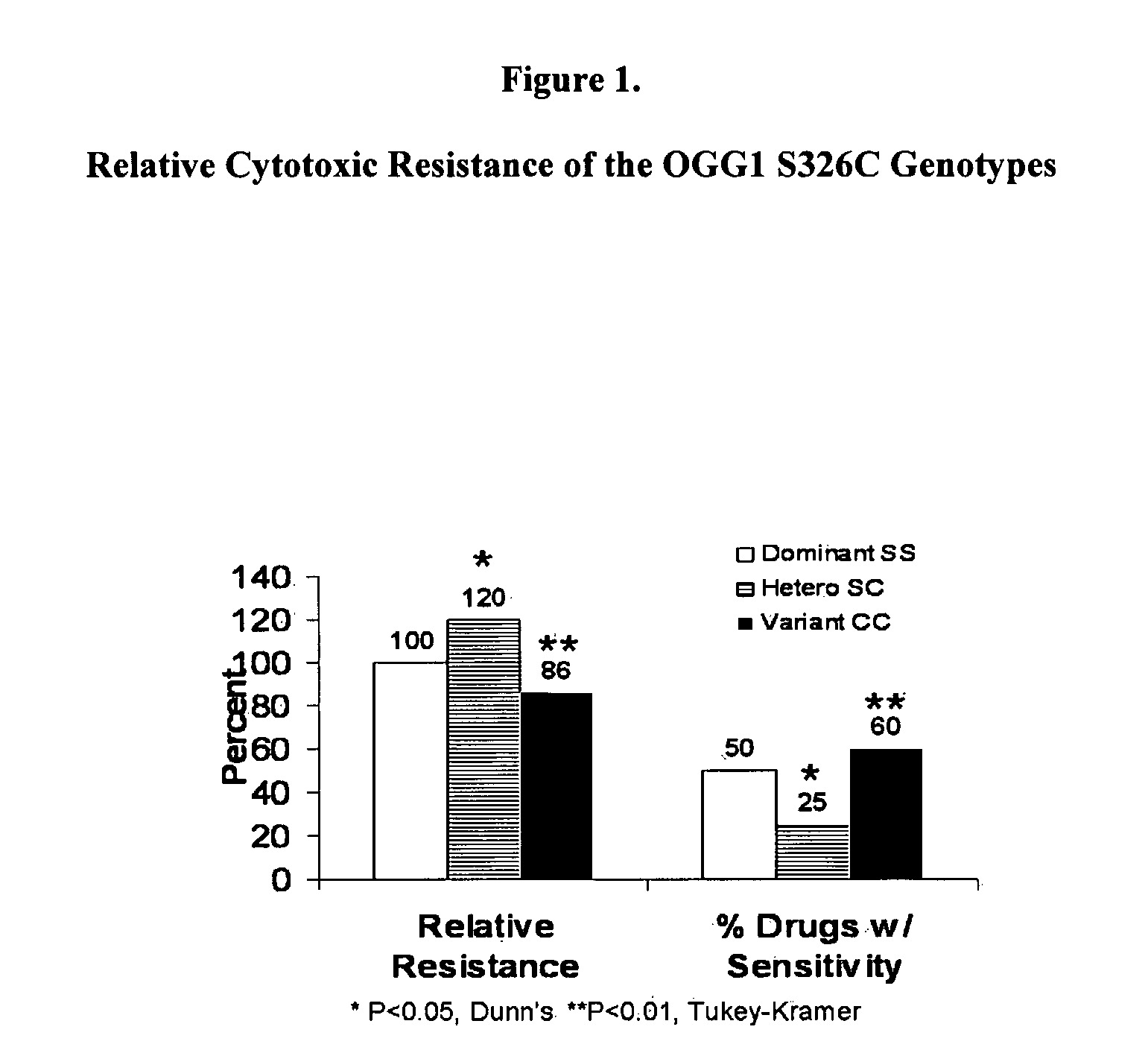Genetic Screening for Polymorphisms in Human Genes that Increase or Decrease Sensitivity to Toxic Agents
a technology of toxic agents and genes, applied in the field of genetic counseling/screening with respect to toxic agents, can solve the problems of direct damage, indirect damage, and damage to cells by toxic agents, and achieve the effect of increasing the sensitivity or resistance of a person to toxic agents and reducing exposure to ultraviolet ligh
- Summary
- Abstract
- Description
- Claims
- Application Information
AI Technical Summary
Benefits of technology
Problems solved by technology
Method used
Image
Examples
example 1
Correlation of Genotype with Cytotoxic Phenotype
[0069] Single nucleotide polymorphisms (SNPs) in the genes under investigation were detected by the Amplifour™ system (Marligen, Gaithersburg Md.), which is a PCR-based detection method using two different fluorescent primers for the dominant or variant alleles with fluorescence detection. The primers are labeled with either fluorescein (green) or sulforhodamine (red) and generate a fluorescence signal of the respective color upon incorporation into a PCR product. Incorporation of only one primer indicates either homozygous dominant with one color, or homozygous variant alleles with the other color, while incorporation of both primers indicates the heterozygous genotype with both colors.
[0070] The cell lines were from the National Cancer Institute (NCI) tumor cell screen and are listed in Table 1. DNA purified from each cell line was analyzed for SNPs at the alleles of interest.
[0071] Each cell line was tested with the drugs listed ...
example 2
Gene TP53 Polymorphism P72R
[0075] The TP53 gene codes for a protein that is important in transcriptional regulation of the cellular response to DNA damage, and in fact has been called the “Guardian of the Genome.” Mutations in this gene increase the risk of cancer, and the gene is therefore a tumor suppressor gene. The polymorphism at position 72 is a change from proline to arginine. The frequency of the TP53 variant allele among the cell lines was 32% while the frequency in the Caucasian and African American population is 27%. The distribution of TP53 P72R polymorphisms among the cell lines did not follow the Hardy-Weinberg distribution. We would expect the frequency of the heterozygous genotype to be greater than the homozygous variant genotype. However, the homozygous dominant genotype was 61%, the homozygous variant was 25% and the heterozygous genotype was 14%. The deviation from the expected distribution, assuming a 27% variant gene frequency, was statistically significant (p...
example 3
Gene OGG1 Polymorphism S326C
[0078] The OGG1 gene codes for the 8-oxo-guanine glycosylase, which is a DNA repair gene that recognizes 8-oxo- or 8-hydroxy-guanine, and other related oxidized bases, in DNA, and makes a single-stranded break in DNA at the site of the damaged base. 8-oxo-guanine is the most common DNA lesion produced by oxidation and its level in the urine has been used as a biomarker for oxidative damage to the animal.
[0079] The normal allele at position 326 is serine. The frequency of the variant cysteine allele in the general population varies with racial grouping: 10% in African Americans, 20% in Caucasians and Hispanics, and 38% in Pacific Rim peoples. In the cell panel the variant allele frequency is 28% of the panel, similar to Caucasian and Hispanic populations. The heterozygous genotype was 32% of the population, while the homozygous dominant and homozygous variant genotypes were 68% of the population.
[0080] The sensitivities of the genotypes to all the drugs...
PUM
| Property | Measurement | Unit |
|---|---|---|
| humidity | aaaaa | aaaaa |
| humidity | aaaaa | aaaaa |
| concentration | aaaaa | aaaaa |
Abstract
Description
Claims
Application Information
 Login to View More
Login to View More - R&D
- Intellectual Property
- Life Sciences
- Materials
- Tech Scout
- Unparalleled Data Quality
- Higher Quality Content
- 60% Fewer Hallucinations
Browse by: Latest US Patents, China's latest patents, Technical Efficacy Thesaurus, Application Domain, Technology Topic, Popular Technical Reports.
© 2025 PatSnap. All rights reserved.Legal|Privacy policy|Modern Slavery Act Transparency Statement|Sitemap|About US| Contact US: help@patsnap.com

